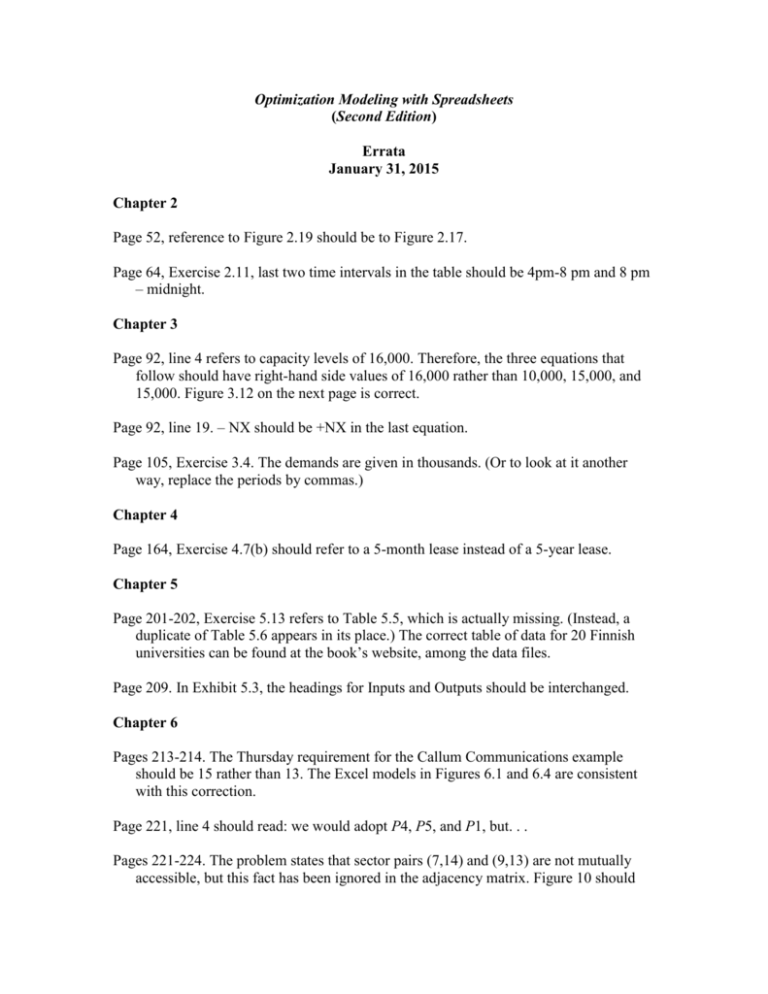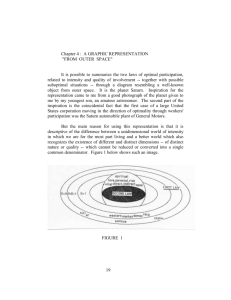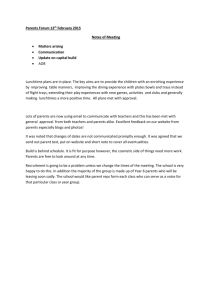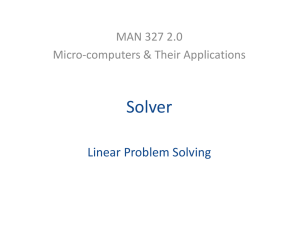Errata
advertisement

Optimization Modeling with Spreadsheets (Second Edition) Errata January 31, 2015 Chapter 2 Page 52, reference to Figure 2.19 should be to Figure 2.17. Page 64, Exercise 2.11, last two time intervals in the table should be 4pm-8 pm and 8 pm – midnight. Chapter 3 Page 92, line 4 refers to capacity levels of 16,000. Therefore, the three equations that follow should have right-hand side values of 16,000 rather than 10,000, 15,000, and 15,000. Figure 3.12 on the next page is correct. Page 92, line 19. – NX should be +NX in the last equation. Page 105, Exercise 3.4. The demands are given in thousands. (Or to look at it another way, replace the periods by commas.) Chapter 4 Page 164, Exercise 4.7(b) should refer to a 5-month lease instead of a 5-year lease. Chapter 5 Page 201-202, Exercise 5.13 refers to Table 5.5, which is actually missing. (Instead, a duplicate of Table 5.6 appears in its place.) The correct table of data for 20 Finnish universities can be found at the book’s website, among the data files. Page 209. In Exhibit 5.3, the headings for Inputs and Outputs should be interchanged. Chapter 6 Pages 213-214. The Thursday requirement for the Callum Communications example should be 15 rather than 13. The Excel models in Figures 6.1 and 6.4 are consistent with this correction. Page 221, line 4 should read: we would adopt P4, P5, and P1, but. . . Pages 221-224. The problem states that sector pairs (7,14) and (9,13) are not mutually accessible, but this fact has been ignored in the adjacency matrix. Figure 10 should have four more zeros in the corresponding locations. When this change is also made in Figure 6.11, the solution will be 4 locations rather than 3. pp. 224-226, Example 6.4. The spreadsheet model in Figure 6.12 is incorrect, and the discussion about using a conflict array is flawed. A correct set packing model has a constraint for each conflicting pair of locations, as shown in the current electronic copy of the exhibits in Chapter 6. Page 245, Exercise 6.5. Jessica has an inventory of 100 six-lb trays and 80 ten-lb trays. Page 245, Exercise 6.6. DMV stands for Division of Motor Vehicles, not “Division of Motor Wyoming.” Chapter 7 Page 254, Figure 7.3. The caption should read, “with contingency constraint,” not mutually-exclusive constraint. Page 256, Figure 7.4. The vertical axis should be labeled TC rather than y. Page 257, referring to Figure 7.5. Families F1 and F3 are at their ceilings (not F1 and F2), and F2 has a volume of 160,000. Page 275, Example 7.5. The upper right-hand element of the cleaning-time table should be 66 instead of 6. (The correct value appears in Figures 7.15-7.21.) Chapter 8 Pages 300-302, Example 8.1. Due to improvements in the software since the book was published, Risk Solver Platform (RSP) is unlikely to generate the Convergence message for any reasonable starting value. It readily finds the optimal lot size of about 342 and generates the optimality message. (Starting at a lot size of 100, Excel's Solver generates the Convergence message; then a re-run generates the Optimality message. Pages 302-303, Example 8.2 and Figure 8.4. The spreadsheet model takes the holding cost as $3/unit/year (rather than 10% of the purchase cost, which theoretically is a better choice if the holding cost behaves like a percentage of the cost). In that case, RSP produces the results shown in the table on page 303. With a holding cost of 10%, the results are slightly different, but the dependence of the final solution on the starting solution resembles the profile shown in the table on page 303. The Convergence message appears when the solution algorithm stops at a lot size of 500, but the Optimality message appears when the algorithm stops at 342. Page 310, line 1 should refer to 12 observations rather than 10. Chapter 9 Page 363, Exercise 9.3. The array is symmetric, and the distance from Paris to Berlin should be 878.











